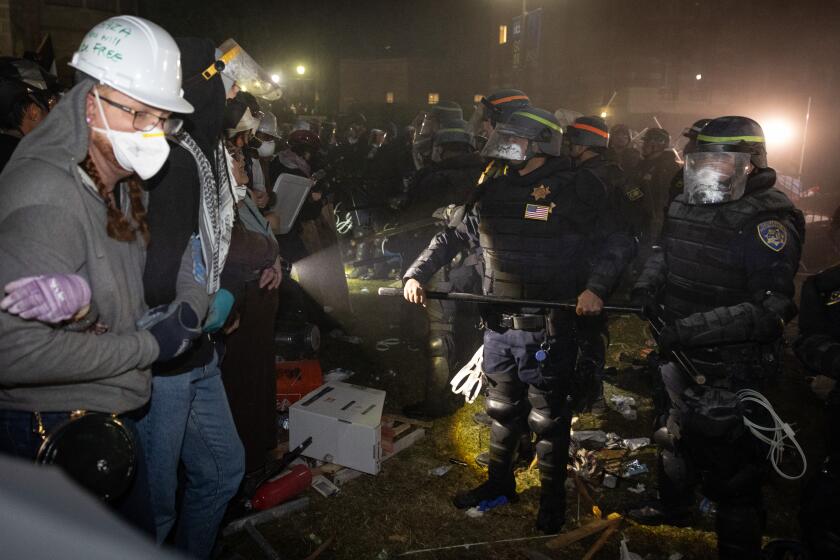Scientists Reduce Estimate of Amazon Deforestation : Environment: But experts say impact on the balances of animal and plant systems may be worse than feared.
Careful analysis of satellite images indicates that the Amazon rain forest is being deforested at a considerably lower rate than recently estimated, but the impact on biological diversity may be greater than feared, University of New Hampshire and NASA scientists report.
That apparent paradox is because of the pattern of forest loss, the scientists report today in the journal Science. Forests in the Amazon region of Brazil are felled in irregular patches that create islands of trees too small to support plants and animals normally found there.
Besides stripping trees from 5,800 square miles of forest annually, an area the size of Los Angeles and Ventura counties combined, logging often fragments habitats and upsets the balance of predator and prey. It also exposes the edges of these forest islands to climate changes, foraging livestock, people and other influences that can harm sensitive plant and animal species.
This so-called edge effect, which the scientists blame for most of the damage in the Amazon, also has been seen near clear-cut logging operations in the Pacific Northwest. But the potential for damage in Amazonia is far higher because those rain forests pack half or more of all plant and animal species onto about 7% of the Earth’s landmass.
“Implications for biological diversity are not encouraging and provide added impetus for the minimization of tropical deforestation,” wrote the researchers, David Skole of the University of New Hampshire and Compton Tucker of the National Aeronautic and Space Administration’s Goddard Space Flight Center in Maryland.
Tucker said he arrived at the glum assessment by combining this new deforestation map with earlier studies about how disturbed habitats affect the diversity of plant and animal species.
“I want to stress that we’ve only estimated what it is,” he said. Field research is required to get a better sense of the problem, he added.
The news may be better when it comes to global warming, Skole said in a telephone interview from Paris, where he is conducting research. Rain forests often are burned or left to rot once they are felled, releasing carbon dioxide. Carbon dioxide and other gases are believed to trap heat close to Earth’s surface in a hypothetical thermal buildup called the greenhouse effect.
“There is almost a straight-line relationship between deforestation and carbon dioxide,” Skole said. “If deforestation declines, that much less carbon dioxide is released.”
Some leading environmental activists accepted the new deforestation estimate but said that reduced logging in Brazil may understate the global threat to rain forests.
“(Logging) might have decreased there,” said Camilla Fox of the Rainforest Action Network in San Francisco, “but it increased in other areas, like Southeast Asia.”
Enio Cordeiro, a spokesman at the Brazilian Embassy in Washington, hailed the deforestation estimates but challenged the assertion that plants and animals are more severely affected than had been believed. “The effect on biodiversity simply is not known,” he said.
Skole and Tucker reached their conclusions after using a computerized Geographic Information System to compare Landsat satellite images of the Amazon Basin from 1978 and 1988. The GIS program let them estimate the annual rate of deforestation and the total loss of forested land during that decade.
They mapped isolated forest islands and estimated the land damaged by edge effects or isolation. Edge effects, as described by specialists, were assumed to affect trees within about six-tenths of a mile of a forest’s border.
“We used very high-resolution imagery to literally draw the boundary of forests to a great deal of accuracy, to plus or minus 100 meters,” Skole said. “It was very tedious work.”
To confirm their conclusions, Compton and Skole compared a number of samples with more detailed images from a French satellite. Then they went to Brazil to study three broad regions on the ground and compare those findings with their satellite estimates.
What they learned was that 92,000 square miles of land have been shorn of trees. That is comparable in size to Oregon and is 5.6% of the virgin Amazon rain forest. Earlier estimates of logged land, using coarse-resolution meteorological satellites or estimates based on partial data, ranged as high as three times that area.
But when edge effects and other impacts are tallied, the total amount of affected area soars to 235,200 square miles, or one-seventh of the entire Brazilian Amazon rain forest. That is an area larger than California and Washington combined.
More to Read
Start your day right
Sign up for Essential California for news, features and recommendations from the L.A. Times and beyond in your inbox six days a week.
You may occasionally receive promotional content from the Los Angeles Times.






